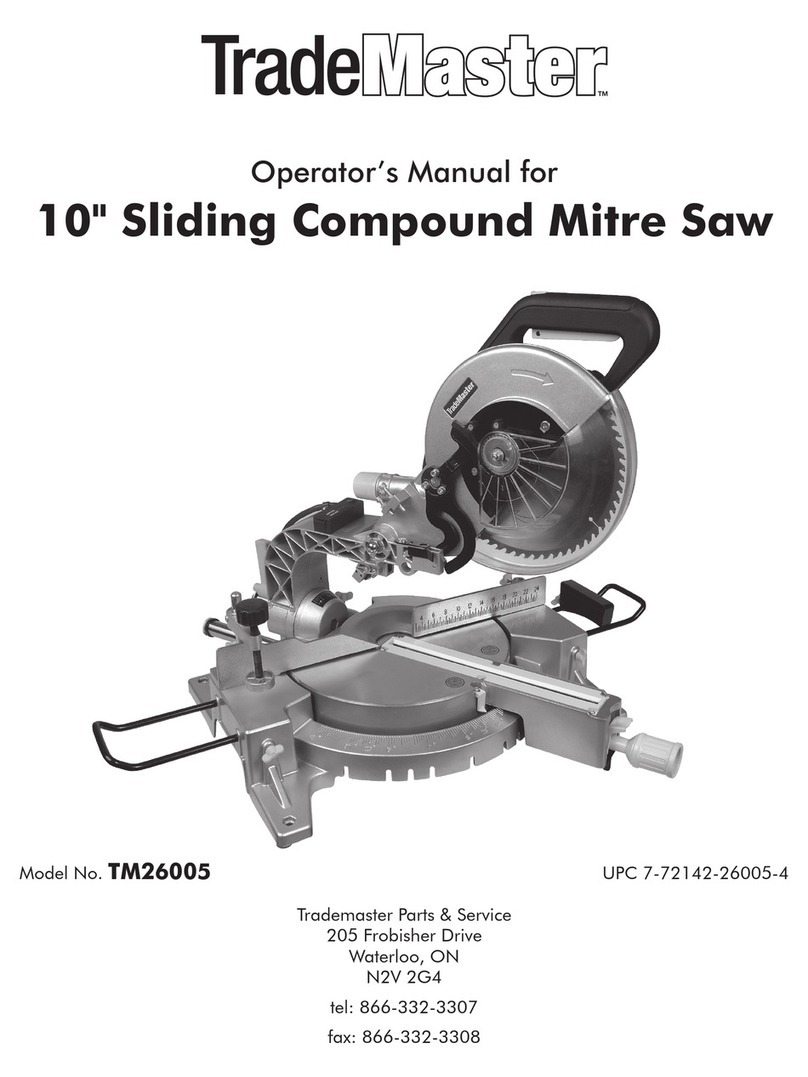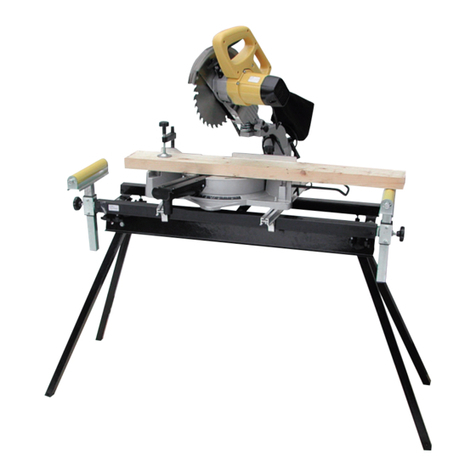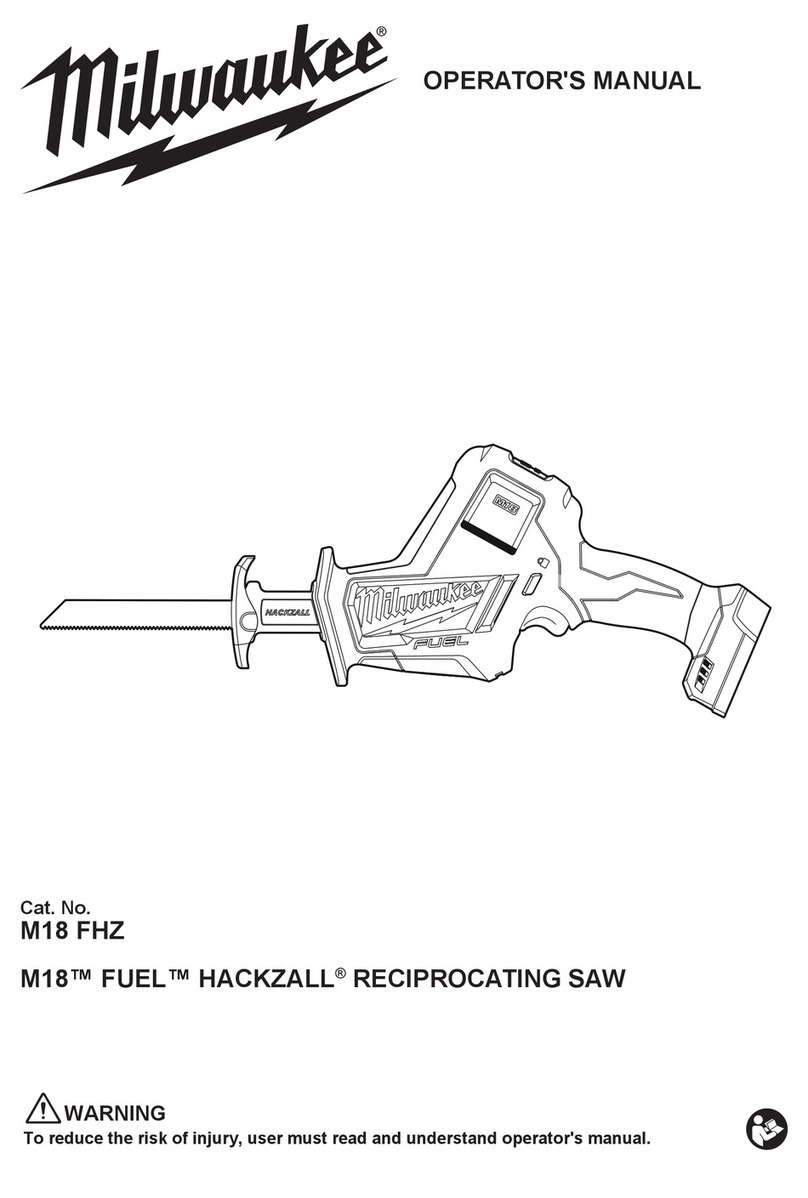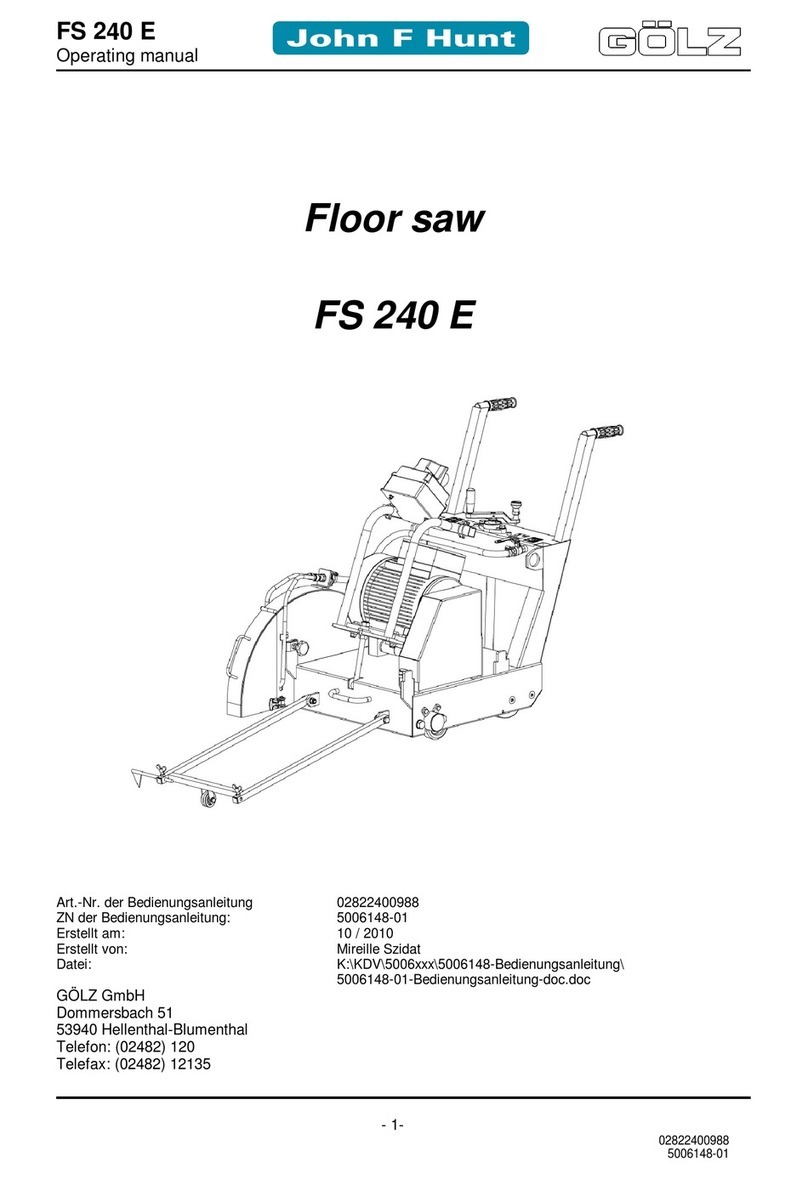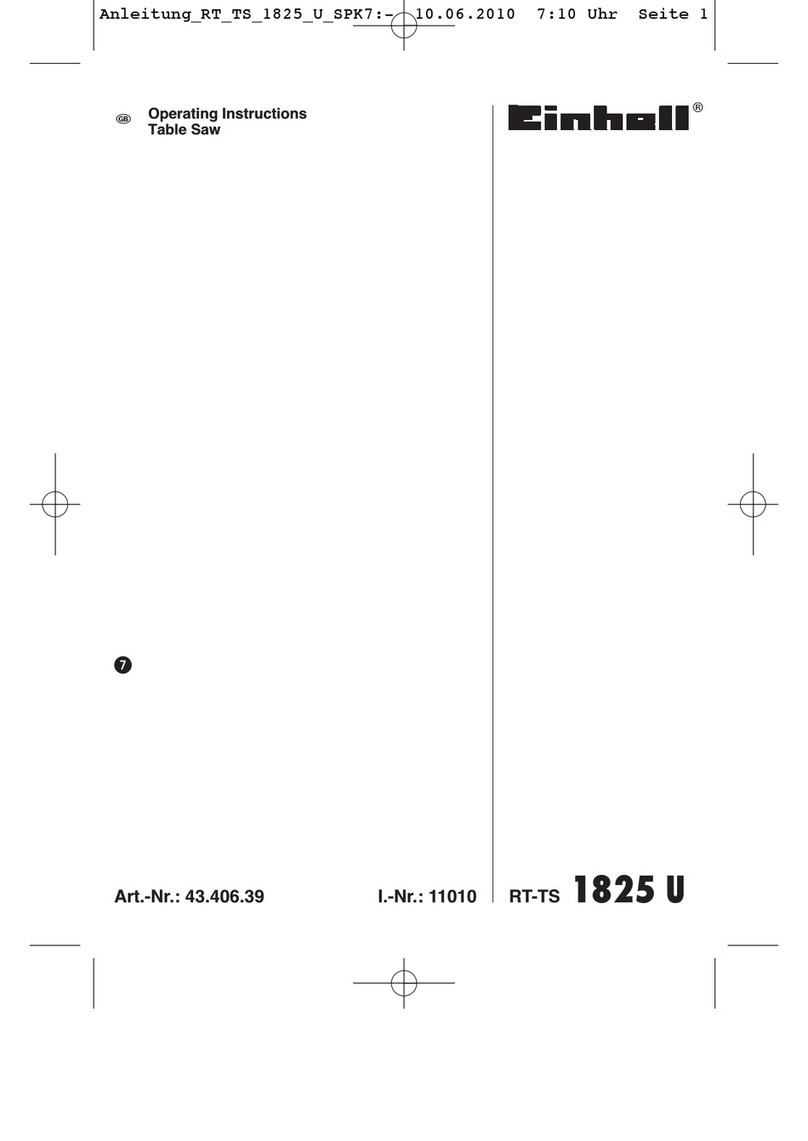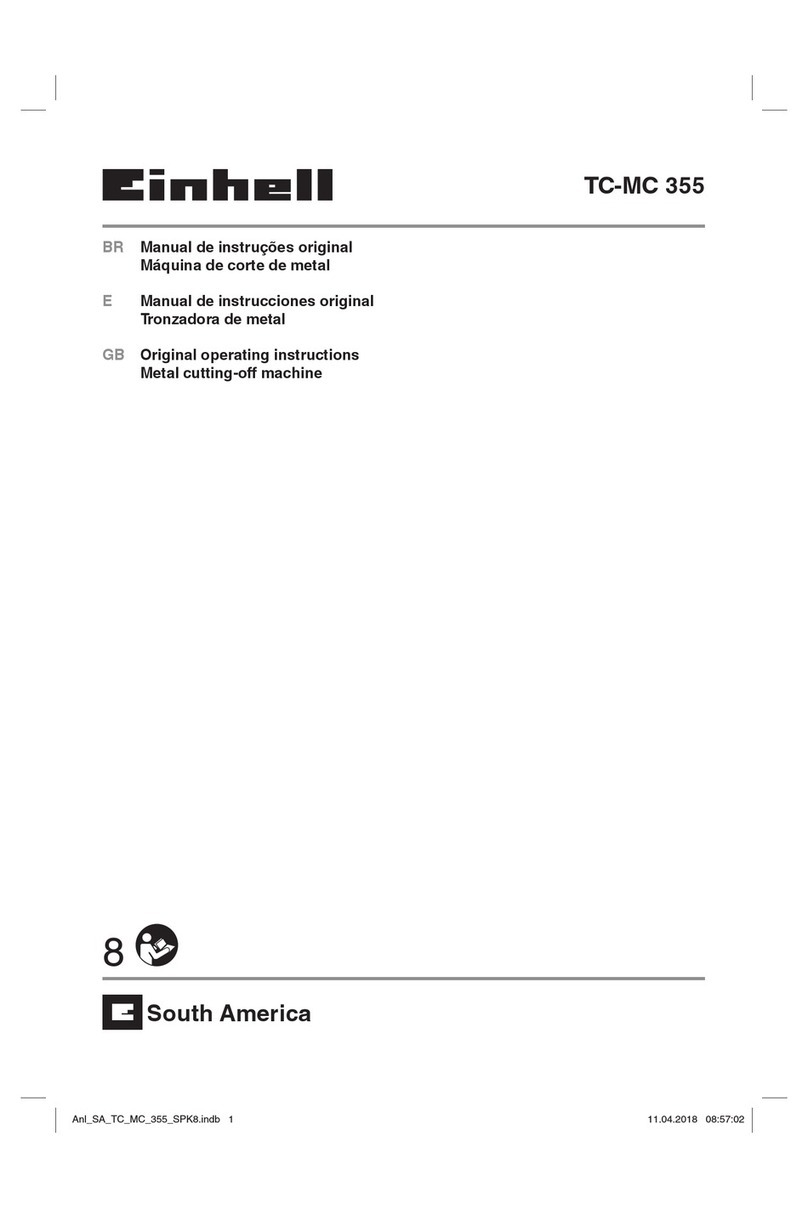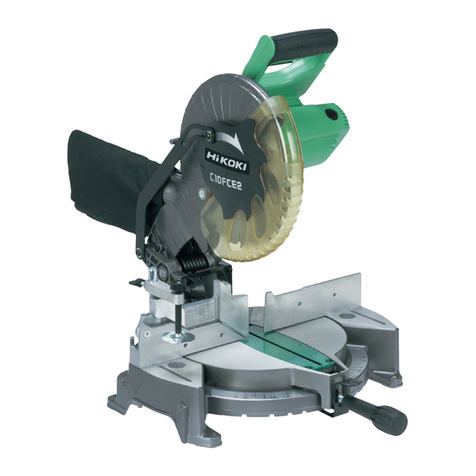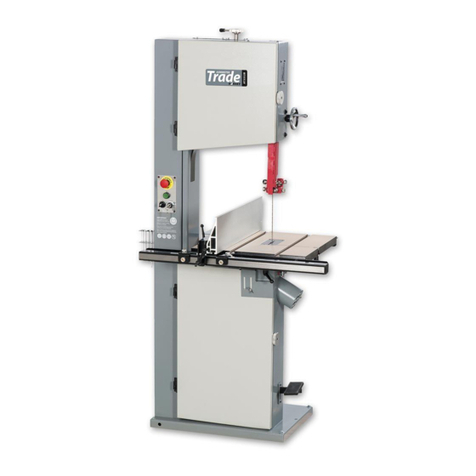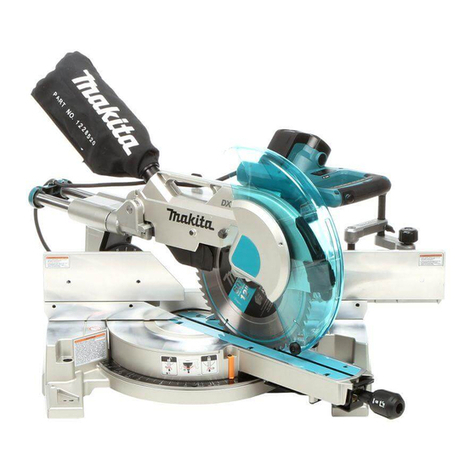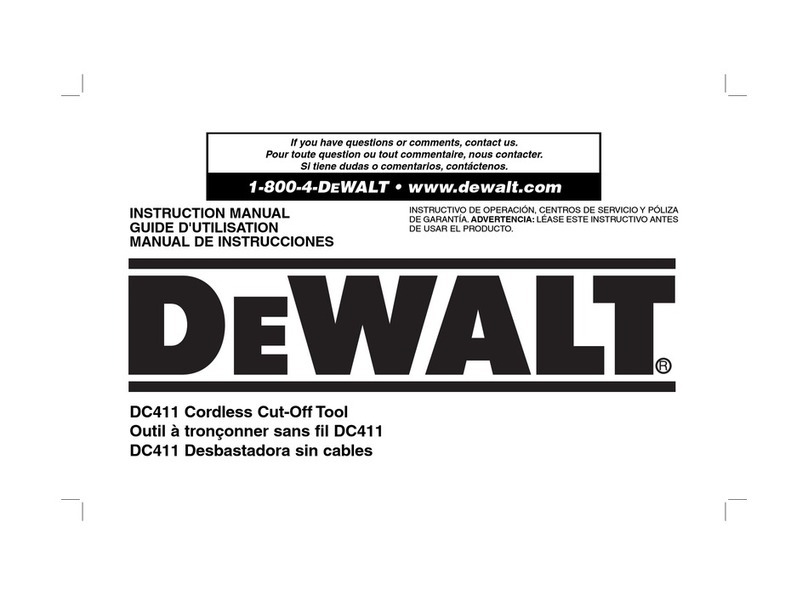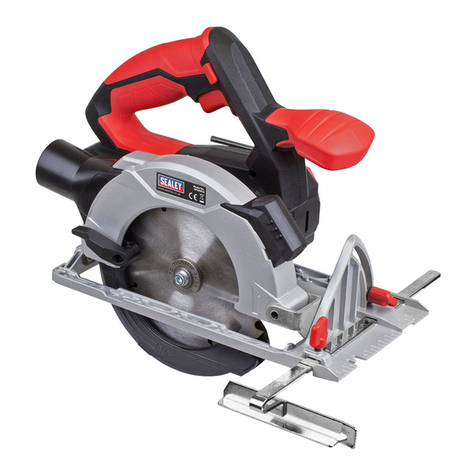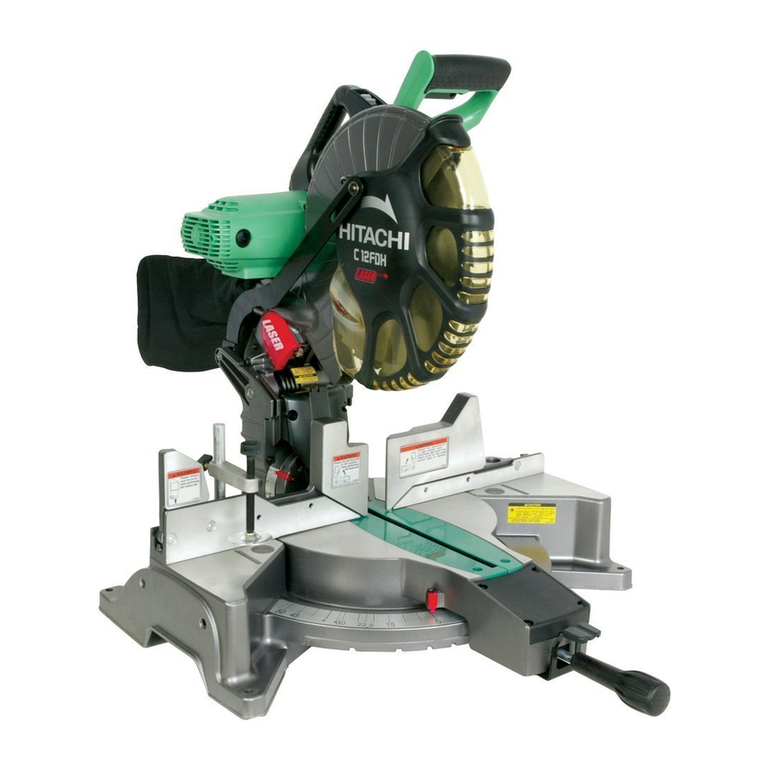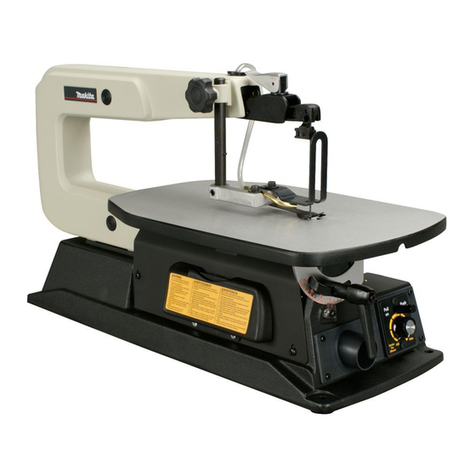Trademaster WE-350DS User manual

Ver: 1.1 07/10/2014

- 1 -
Contents
Chapter 1
ACCIDENT PREVENTION AND SAFETY
REGULATION
1.1 Advice for the operator .........................................2
1.2 The electrical equipment according to European
Standard" CENELEC EN 60 204-1" (1992)................2
1.3 Emergencies according to European Standard
“CENELEC EN 60 204-1 (1992)”................................2
Chapter 2
MACHINE DIMENSIONS TRANSPORT
INSTALLATION DISMANTLING
2.1 Machine dimensions.............................................2
2.2 Assembling the Saw and the Base.......................2
2.3 Minimum requirements for housing the machine..3
2.4 Anchoring the machine.........................................3
2.5 Instructions for assembly of the loose parts and
accessories.................................................................3
2.6 Deactivation of machine .......................................3
2.7 Dismantling...........................................................3
Chapter 3
THE MACHINE’S FUNCTIONAL PARTS
3.1 The saw arm.........................................................3
3.2 Controls.................................................................4
3.3 Vice adjustment ....................................................4
3.4 Cutting angle adjustment......................................5
3.5 The base...............................................................5
3.6 Saw frame return stroke-limiting device ...............5
3.7 The operation cycle ..............................................5
Chapter 4
ADVICE ON USING YOUR BANDSAW
4.1 Recommendations and advice for using the
machine ......................................................................6
Chapter 5
ADJUSTING YOUR MACHINE
5.1 Blade tension assembly........................................7
5.2 Adjusting the blade guide .....................................7
5.3 Changing the blade...............................................7
5.4 Adjusting the blade to the flywheels.....................8
Chapter 6
ROUTINE AND SPECIAL MAINTENANCE
6.1 Daily maintenance................................................8
6.2 Weekly maintenance............................................8
6.3 Monthly maintenance ...........................................8
6.4 Six-monthly maintenance.....................................8
6.5 Maintenance of other machine parts....................8
6.6 Oils for lubricating coolant....................................8
6.7 Oil disposal...........................................................9
6.8 The gear box ........................................................9
6.9 Special maintenance............................................9
Chapter 7
TECHNICAL CHARACTERISTICS
7.1 Table of cutting capacity and technical details.....9
Chapter 8
MATERIAL CLASSIFICATION AND CHOICE OF
TOOL
8.1 Definition of materials.........................................10
8.2 Selecting blade...................................................10
8.3 Teeth pitch..........................................................10
8.4 Cutting and advance speed................................10
8.5 Blade running-in .................................................10
8.6 Blade structure ...................................................10
8.7 Blade type...........................................................11
Chapter 9
NOISE TESTS..........................................................11
Chapter 10
WIRING DIAGRAM..................................................12
Chapter 11
TROUBLESHOOTING
11.1 - Blade and cut diagnosis.................................13
11.2 - Electrical components diagnosis.................... 17
Chapter 12
MACHINE COMPONETS
12.1 Parts list............................................................18
12.2 Explosion drawings...........................................21

- 2 -
1ACCIDENT PREVENTION AND
SAFETY REGULATION
This machine has been designed to comply with
national and community accident-prevention
regulations. Improper use and/or tampering with the
safety devices will relieve the manufacturer of all
responsibility.
1.1 Advice for the operator
- Check that the voltage indicated on machine motor is
the same as the line voltage.
- Check the efficiency of your electric supply and
grounding system; connect the power cable of the
machine to the socket and the ground lead
(yellow-green in color) to the grounding system.
- When the saw frame is in suspended mode (or raised)
the blade must not move.
- Only the blade section used for cutting must be kept
unprotected. To remove guards operate on the
adjustable head.
- It is forbidden to use the machine without its shields
- Always disconnect the machine from the power
socket before blade change or carrying out any
maintenance job, even in the case of abnormal
machine operation.
- Always wear suitable eye protection.
- Never put your hands or arms into the cutting area
while the machine is operating.
- Do not shift the machine while it is cutting.
- Do not wear loose clothing like: shirts with sleeves
that are too long, gloves that are too big, bracelets,
chains or any other object that could get caught in the
machine during operation. Tie back long hair.
- Keep the area free of equipment, tools, or any other
object.
- Perform only one operation at a time. Never have
several objects in your hands at the same time.
Keep your hands as clean as possible.
- All internal operations, maintenance or repairs, must
be performed in a well-lit area or where there is
sufficient light from extra sources so as to avoid the
risk of even slight accidents
1.2 The electrical equipment according to
European Standard" CENELEC EN 60 204-1" which
assimilates, with some integrating modifications,
the publication "IEC 204-1 (1992)"
- The electrical equipment ensures protection against
electric shock as a result of direct or indirect contact.
The active parts of this equipment are housed in a box
to which access is limited by screws that can only be
removed with a special tool; the parts are fed with
alternating current as low voltage (24V). The
equipment is protected against splashes of water and
dust.
- Protection of the system against short circuits is
ensured by means of rapid fuses and grounding; in
the event of a motor overload, protection is provided
by a thermal probe.
- In the event of a power cut, the specific start-up
button must be reset.
- The machine has been tested in conformity with point
20 of EN 60204
1.3 Emergencies according to European Standard
“CENELEC EN 60 204-1 (1992)”
- In the event of incorrect operation or of danger
conditions, the machine may be stopped immediately
by pressing the red mushroom button.
- The casual or voluntary removal of the blade cover of
the flywheels causes the stepping-in of a interlock
switch that automatically stops all machine functions.
- In case blade breakage, the tension release
microswitch disconnects all machine functions.
NOTE: Resetting of machine operation after each
emergency stop requires specific restart button.
2 MACHINE DIMENSIONS
TRANSPORT INSTALLATION
DISMANTLING
2.1 Machine dimensions
2.2 Assembling the Saw and the Base
- Join panels A, B, and C by inserting tenon into
mortise as shown in circle diagram 1 and 2.
- Fasten bottom panel D into the joined panels A, B,
and C using set screws that are provided
- Attach panel F to panel C with provided set screws.
- Attach control box with two provided set screws.
- Mount the saw unit on the base as shown in drawing
5.
- Fasten the saw unit to the base with provided set
screws.

- 3 -
If the machine needs to be moved in its own packing,
use a forklift truck or sling it with straps as illustrated in
drawing 6 above.
2.3 Minimum requirements for housing the
machine
- Main voltage and frequency must comply with the
machine’s motor requirements.
- Environment temperature should fall within –10 ºC to
+50 ºC.
- Relative humidity cannot be over 90%.
2.4 Anchoring the machine
Position the machine on a firm cement floor,
maintaining, at the rear, a minimum distance of 800
mm from the wall; anchor it to the ground as shown in
the diagram, using screws and expansion plugs or tie
rods sunk In cement, ensuring that it is sitting level.
2.5 Instructions for assembly of the loose parts
and accessories
Fit the components supplied:
Detail 1 Mount bar-stop rod
Detail 2 Mount and align the roll-supporting arm as per
the counter-vice table.
2.6 Disactivation of machine
- If the sawing machine is to be out of use for a long
period, it is advisable to proceed as follows:
I) Detach the plug from the electric supply panel
2) Loosen blade
3) Release the arch return spring
4) Empty the coolant tank
5) Carefully clean and grease the machine
6) If necessary, cover the machine.
2.7 Dismantling (due to deterioration and/or
(obsolescence)
General rules
If the machine is to be permanently demolished and/or
scrapped, divide the material to be disposed of
according to type and composition, as follows:
1) Cast iron or ferrous materials,composed of metal
alone, are secondary raw materials, so they may be
taken to an iron foundry for re-smelting after having
removed the contents (classified in point 3).
2) Electrical components, including the cable and
electronic material (magnetic cards, etc.), fall within the
category of material classified as being assimilated to
urban waste according to the laws of your local, state,
or federal government, so they may be set aside for
collection by the public waste disposal service;
3) Old mineral and synthetic and/or mixed oils,
emulsified oils and greases are considered hazardous
or special refuse, so they must be collected,
transported and disposed of at a special waste
disposal service.
NOTE: The standards and legislation concerning
refuse is in a constant state of evolution, therefore is
subject to changes. The user must keep informed of
the regulations at the time of disposal as these may
differ from those described above.
3 THE MACHINE’S FUNCTIONAL
PARTS
3.1 The saw arm
Machine part consisting of drive members (gear motor
or variable speed motor, flywheels), tightening and
guide (blade tightening slide, blade guide blocks) of
tool.

- 4 -
3.2 Controls
A. Hydraulic Flow control valve
B. Hydraulic regulation valve
J. Trigger Switch
C1 C2
C. Fork handle
S. Spring knob
C1. Manual position
C2. Auto position
D. Manual/Auto selector
E. Start/Reset push button
F. Speed selector
G. Main connect switch
H. Indicator light
K. Emergency push button
3.3 Vice adjustment
- The device does not require any particular
adjustment; in case of excess play of the sliding guide,
tighten slide screw more.
To move the vise in either direction, the vise jaw must
be unlocked at two points.
- Release the track support by turning handle (1)
counter-clockwise.
- Release the vise by moving the lever (2) to the left.
- The vise (5) may now be moved to right position (7)
or left position (6) by pushing it with one hand on the
vise and the other hand on the track handle (1).
- Once in position, move the lever (2) to the right to
lock it into position. If the lever (2) is not between
the vise/bed mounts and facing the user, then the
vise will not be able to lock. If the vise lever (2) has
gone beyond or is obstructed by a vise/bed mount,
then use the following procedures.
- Adjust the lever (2) by grasping at the pivot point (P)
and lowering it, which may assist in the adjustment.
The lever can now be freely rotated into a more
convenient position. Some movement of the vise
jaw may be required. Raise the lever (2) then move
to the right to lock.
- Lock the track support (1) by turning handle
clockwise.
Clamping the Work Piece
- Place work piece between the jaws.
- Use the hand wheel to approach the vise jaws to the
work piece, leaving 3-4mm of space. Lock down work
piece and raise the lever (4). Push start button (E).
When the cutting cycle is finished, release vise by
lowering lever (4). Upon releasing the lever (4), the
vise jaw will open to the same distance that was set
initially. This allows for rapid loading of same size
material.
A
B
J 4 5 2
1
3

- 5 -
3.4 Cutting angle adjustment
Cutting at angles
- Using the right side, angles can be cut up to 60
degrees. This requires that vise jaw to be set on the
left side (6). Use the procedures for 3.2 Vise
Adjustment to place it in left side position.
- Using the left side, angles can be cut up to 45
degrees. This requires the vise jaw to be set on the
right side (7). Use the procedures for 3.2 Vise
Adjustment, to place it in right side position.
- Unlock lever (3) and use the handle under the control
box to rotate the saw frame arm until you reach
mechanical stop and check if the index corresponds
to 45 degrees; if not, operate on the set screws to
make measures meet.
3.5 The base
- A structure supporting the SAW ARM (revolving arm
for gradual cutting and respective blocking system),
the VICE, the BAR STOP, the ROLLER for the support
of the material. The base houses the cooling liquid
TANK and PUMP.
3.6 Saw frame return stroke-limiting device
The hydraulic cylinder is ideal for the cutting of thin or
STAINLESS STEEL section bars, that determines a
constant lowering and consequently a good efficiency
of the blade throughout the work phase. By adjusting
the flow control valve (A), this device can be
accommodated to the different situations and
applications. Defectiveness in the control of the
lowering may be caused by the drop in braking power
of the device due to the long-term blowby of the
braking fluid.
3.7 The operation cycle
Before operating, all the main organs of the machine
must be set in optimum conditions.
Operation Procedure:
A. Trigger switch operation
- Close the hydraulic flow control valve (A) by turning
the valve clockwise all the way to the end.
- Raise the saw arm.
- Lift the spring knob (S) to release the pin from its slot.
This will free the fork handle (C). Move the handle
to the manual position (C1). Lift the spring knob (S)
and secure its pin into its slot.
- Use manual/auto selector (D) to select handle icon.
- Select cutting speed by turning speed selector (F).
Turtle is low speed, rabbit is high speed, and ‘O’ is
neutral.
- Turn main connect switch (G) to the ON position.
Check that the indicator light (H) is on.
- Load work piece and clamp it properly.
- Fully open the hydraulic flow regulation valve (B) by
turning the valve counter-clockwise all the way to the
end.
6 7
A
B

- 6 -
BLADE CUTTING DIRECTION
- Press trigger switch (J) to start operation.
- If cutting pipe with thin walls, reduce the saw arm
descent rate by adjusting the flow control valve (A)
- Press the emergency push button (K) down to shut
off all functions. To release the emergency push
button rotate the mushroom shaped button (K)
clock-wise. The button will pop up and then the
cutting cycle can be restarted.
- In general, start cuts by slightly turning hydraulic flow
control valve (A) counter-clockwise from 2 to 3 to
control the saw arm descent rate. If the arm
descends too quickly, turn the hydraulic flow
regulation valve (B) clockwise all the way back to stop
its descent. A saw arm dropping too quickly can
cause the blade to stall on the work piece and the
machine will shut off. Push down on emergency
push button (K) to immediately stop all machine
functions.
C1 C2
B. Auto cutting operation
- Close the hydraulic flow control valve (A) by turning
the valve clockwise all the way to the end.
- Raise the saw arm.
- Lift the spring knob (S) to release the pin from its slot.
This will free the fork handle (C). Move the handle
to the auto position (C2). Lift the spring knob (S)
and secure its pin into its slot.
- Use manual/auto selector (D) to select auto.
- Select cutting speed by turning speed selector (F).
Turtle is low speed, rabbit is high speed, and ‘O’ is
neutral.
- Turn main connect switch (G) to the ON position.
Check that the indicator light (H) is on.
- Load work piece and clamp it properly.
- Press start/reset button (E) to start machine. Check
that the blade is running in the correct direction.
- Slightly pull the saw arm down to get rid of air
bubbles from the hydraulic cylinder.
- Adjust hydraulic flow control valve (A) by slightly
turning the valve counter-clockwise to let saw arm
descend and start cutting.
- Press the emergency push button (K) down to shut
off all functions. To release the emergency shut off
rotate emergency push button (K) clock-wise. The
button will pop up and then the cutting cycle can be
restarted.
- In general, start cuts by slightly turning hydraulic flow
control valve (A) counter-clockwise from 2 to 3 to
control the saw arm descent rate. If the arm
descends too quickly, turn hydraulic flow regulation
valve (B) clockwise all the way back to stop its
descent. A saw arm dropping too quickly can cause
the blade to stall on the work piece and the machine
will shut off. Push down on emergency push button
(K) to immediately stop all machine functions.
-
4ADVICE ON USING YOUR BANDSAW
4.1 Recommendations and advice for using the
machine
The machine has been designed to cut metal building
materials, with different shapes and profiles, used in
workshops, turner's shops and general mechanical
structural work,
Only one operator is needed to use the machine, that
must stand as shown in the picture.
- Before starting each cutting operation, ensure that
the part is firmly clamped in the vice and that the end
is suitably supported.
- These figures below show examples of suitable
clamping of different section bars, bearing in mind the
cutting capacities of the machine in order to achieve a
good efficiency and blade durability.
K
J

- 7 -
- Do not use blades of a different size from those
stated in the machine specifications.
- If the blade gets stuck in the cut, release the running
button immediately, switch off the machine, open the
vice slowly, remove the part and check that the blade
or its teeth are not broken. If they are broken, change
the tool.
- Before carrying out any repairs on the machine,
consult the dealer.
5 ADJUSTING YOUR MACHINE
5.1 Blade tension assembly
The ideal tension of the blade is achieved rotating the
handwheel until it the microswitch, that actuates the
operation of the machine is actuated
WARNING: the position of this switch is factory set
during inspection, after having tightened the blade on
the lengthening values indicated by its manufacturer as
per specific dimensions set with the help of a special
instrument. When replacing the blade, if the
thickness and the width differ, it will be necessary to
correct the projection of the switch. For this purpose
we suggest to strictly select blades having the same
features as mounted originally.
5.2 Adjusting the blade guide
- Disconnect the machine from the power source.
- Use a Hex. Wrench to loosen Hex. Socket screw (A)
on the square lock plate.
- Hold the handle (B) and slide blade guide block as
close as possible to the material without interfering
with the cut
- Tighten the Hex. Socket screw (A).
- Reconnect the machine to power source.
Blade guide blocks
The blade is guided by means of adjustable pads set in
place during inspection as per the thickness of the
blade with minimum play as shown in the figure.
In case the blade needs to be replaced, make sure to
always install 0.9mm thick blades for which the blade
guide pads have been adjusted. In the case of toothed
blades with different thicknesses adjustment should be
carried out as follows:
- Loosen nut (C), screw (B) and loosen dowel (D)
widening the passage between the pads.
- Loosen the nuts (H) and the dowels (I) and rotate the
pins (E - G) to widen the passage between the
bearings (F).
- To mount the new blade: place the pad (A) on the
blade, loosening the dowel, allow a play of 0.04 mm
for the sliding of the toothed blade, lock the relative
nut and screw (B), Rotate the pins (E - G) until the
bearings rest against the blade as indicated in the
figure and then secure the dowels (I) and nut (H).
- Make sure that between the blade and the upper
teeth of the pad (L) this is at least 0.2 - 0.3 mm of
play; if necessary, loosen the screws that fasten the
blocks and adjust accordingly.
BEFORE PERFORMING THE FOLLOWING
OPERATIONS, THE ELECTRIC POWER SUPPLY
AND THE POWER CABLE MUST BE COMPLETELY
DISCONNECTED.
5.3Changing the blade
To change the blade:
- Lift the saw arm.
- Loosen the blade with the handwheel, remove the
mobile blade-guard cover, open the flywheel guards
and remove the old blade from the flywheels and the
blade guide blocks.
- Assemble the new blade by placing it first between
the pads and then on the race of the flywheels,
paying particular attention to the cutting direction of
the teeth.
- Tension the blade and make sure it perfectly fits
inside the seat of the flywheels.
B
A

- 8 -
- Assemble the mobile blade-guide end, the flywheel
guard, and fasten it with the relative knobs. Check
that the safety microswitch is activated otherwise
when electric connection will be restored the machine
will not start.
5.4 Adjusting the blade to the flywheels
1. Loosen the hex nut screws A, B, and C.
2. Use an Allen wrench on setscrew D to adjust the
tilt of the flywheel.
-Turning the setscrew, D clockwise will tilt flywheel so
that the blade will ride closer to the flange.
-Turning the setscrew, D counter-clockwise will tilt the
flywheels so the blade will ride away from the flange.
If the blade rides away too far then it will come off.
After the adjustment is finished, fasten the hex nut
screws in this order: A, B, and C.
Checking the adjustment of the blade
Use a strip of scrap paper and slide it between the
blade and the flywheel while it is running.
-if the paper is cut then the blade is riding too close to
the flange. Re-adjust.
-if you notice that the blade is riding away from the
flange. Then re-adjust.
WARNING: Always assemble blades having
dimensions specified in this manual and for which the
blade guide heads have been set; otherwise, see
chapter on "Description of the operating cycle" in the
section Starting-up.
6 ROUTINE AND SPECIAL
MAINTENANCE
THE MAINTENANCE JOBS ARE LISTED BELOW,
DIVIDED INTO DAILY, WEEKLY, MONTHLY AND
SIX-MONTHLY INTERVALS. IF THE FOLLOWING
OPERATIONS ARE NEGLECTED, THE RESULT
WILL BE PREMATURE WEAR OF THE MACHINE
AND POOR PERFORMANCE.
6.1 Daily maintenance
- General cleaning of the machine to remove
accumulated shavings.
- Clean the lubricating coolant drain hole to avoid
excess fluid.
- Top off the level of lubricating coolant.
- Check blade for wear.
- Rise of saw frame to top position and partial
slackening of the blade to avoid useless yield stress.
- Check functionality of the shields and emergency
stops.
6.2 Weekly maintenance
- Thorough cleaning of the machine to remove
shavings, especially from the lubricant fluid tank.
- Removal of pump from its housing, cleaning of the
suction filter and suction zone.
- Clean the filter of the pump suction head and the
suction area.
- Use compressed air to clean the blade guides (guide
bearings and drain hole of the lubricating cooling).
- Cleaning flywheel housings and blade sliding
surfaces on flywheels.
6.3 Monthly maintenance
- Check the tightening of the motor flywheel screws.
- Check that the blade guide bearings on the heads are
perfect running condition.
- Check the tightening of the screws of the gear motor,
pump, and accident protection guarding.
6.4 Six-monthly maintenance
- Continuity test of the equipotential protection circuit.
6.5 Maintenance of other machine parts
The worm drive gearbox mounted on the machine is
maintenance-free guaranteed by its manufacture.
6.6 Oils for lubricating coolant
Considering the vast range of products on the market,
the user can choose the one most suited to their own
TOP
A C
B
Setscrew D
A Tilt in this direction will cause the
b
l
ade
to
ri
de
to
w
a
r
ds
t
h
e
fl
a
n
ge
A Tilt in this direction will cause the
b
l
ade
to
ri
de
a
w
ay
fr
o
m
t
h
e
fl
a
n
ge
Top view
Set screw D
paper
Blade direction
flywheel

- 9 -
requirements, using as reference the type SHELL
LUTEM OIL ECO. THE MINIMUM PERCENTAGE
OF OIL DILUTED IN WATER IS 8 - 10 %.
6.7 Oil disposal
The disposal of these products is controlled by strict
regulations. Please see the Chapter on "Machine
dimensions Transport - Installation" in the section
on Dismantling.
6.8 The gear box
The gear box requires periodic changing of oil. The
oil must be changed by the first 6 months of a new
machine and every year thereafter.
To change the gear box oil
- Disconnect the machine from the power source.
- Raise the saw arm to vertical position
- Release the drain hold (O) to draw off gear oil by
loosening the hex socket screw (P).
- Replace the screw (P) after oil completely flows
off.
- Place the saw arm back to horizontal position.
- Fill Gear box with approximately .3 liter of gear oil
through the hole of the vent screw (Q)
For reference, use SHELL type gear oil or Mobile gear
oil #90.
6.9 Special maintenance
Special maintenance must be conducted by skilled
personnel. We advise contacting your nearest dealer
and/or importer. Also the reset of protective and safety
equipment and devices (of the reducer), the motor, the
motor pump, and other electrical components requires
special maintenance.
7TECHNICAL CHARACTERISTICS
7.1 Table of cutting capacity and technical details

- 10 -
8MATERIAL CLASSIFICATION AND
CHOICE OF TOOL
Since the aim is to obtain excellent cutting quality, the
various parameters such as hardness of the material,
shape and thickness, transverse cutting section of the
part to be cut, selection of the type of cutting blade,
cutting speed and control of saw frame lowering.
These specifications must therefore be harmoniously
combined in a single operating condition according to
practical considerations and common sense, so as to
achieve an optimum condition that does not require
countless operations to prepare the machine when
there are many variations in the job to be performed.
The various problems that crop up from time to time
will be solved more easily if the operator has a good
knowledge of these specifications.
8.1 Definition of materials
The table above lists the characteristics of the
materials to be cut. So as to choose the right tool to
use.
8.2 Selecting blade
First of all the pitch of the teeth must be chosen, in
other words, the number of teeth per inch (25,4 mm)
suitable for the material to be cut, according to these
criteria:
- Parts with a thin and/or variable section such as
profiles, pipes and plate, need close toothing, so that
the number of teeth used simultaneously in cutting is
from 3 to 6;
- Parts with large transverse sections and solid
sections need widely spaced toothing to allow for the
greater volume of the shavings and better tooth
penetration;
- Parts made of soft material or plastic (light alloys,
mild bronze, Teflon, wood, etc.) also require widely
spaced toothing;
- Pieces cut in bundles require combo tooth design.
8.3 Teeth pitch
As already stated, this depends on the following
factors:
-Hardness of the material
-Dimensions of the section
-Wall thickness.
8.4 Cutting and advance speed
The cutting speed (m/min) and the advance speed
(cm2/min =area traveled by the disk teeth when
removing shavings) are limited by the development of
heat close to the tips of the teeth.
- The cutting speed is subordinate to the resistance of
the material (R = N/mm2), to its hardness (HRC) and
to the dimensions of the widest section.
- Too high an advance speed (= lowering of the saw
frame) tends to cause the disk to deviate from the
ideal cutting path, producing non rectilinear cuts on
bath the vertical and the horizontal plane.
The best combination of these two parameters can be
seen directly examining the chips.
Long spiral-shaped chips indicate ideal cutting.
Very fine or pulverized chips indicate lack of feed
and/or cutting pressure.
Thick and/or blue chips indicate overload of the blade.
8.5 Blade running-in
When cutting for the first time, it is good practice
to run in the tool making a series of cuts at a low
advance speed (= 30-35 cm2/min on material of
average dimensions with respect to the cutting
capacity and solid section of normal steel with R =
410-510 Nimm2). Generously spraying the cutting
area with lubricating coolant.
8.6 Blade structure
Bi-metal blades are the most commonly used. They
consist of a silicon-steel blade backing by a laser
welded high speed steel (HHS) cutting edge. The type
of stocks are classified in M2, M42, M51 and differ
from each other because of their major hardness due
to the increasing percentage of Cobalt (Cc) and
molybdenum (Mo) contained in the metal alloy

- 11 -
8.7 Blade type
They differ essentially in their constructive
characteristics, such as:
- Shape and cutting angle of tooth
-Pitch
- Set
Shape and angle of tooth
REGULAR TOOTH: Oº rake and constant pitch.
Most common form for transversal or inclined cutting of
solid small and average cross-sections or pipes, in
laminated mild steel and gray iron or general metal.
POSITIVE RAKE TOOTH: 9º - 10º positive rake and
constant pitch.
Particular use for crosswise or inclined cuts in solid
sections or large pipes, but above all harder materials
(highly alloyed and stainless steels, special bronze and
forge pig iron).
COMBO TOOTH: pitch varies between teeth and
consequently varying teeth size and varying gullet
depths. Pitch varies between teeth, which ensures a
smoother, quieter cut and longer blade life owing to the
lack of vibration.
Another advantage offered in the use of this type of
blade in the fact that with an only blade it is possible to
cut a wide range of different materials in size and type.
COMBO TOOTH: 9º - 10º positive rake.
This type of blade is the most suitable for the cutting of
section bars and large and thick pipes as well as for
the cutting of solid bars at maximum machine capacity.
Available pitches: 3-4/4-6.
SETS
Saw teeth bent out of the plane of the saw body,
resulting in a wide cut in the workpiece.
REGULAR OR RAKER SET:Cutting teeth right and
left, alternated by a straight tooth.
Of general use for materials with dimensions superior
to 5 mm. Used for the cutting of steel, castings and
hard nonferrous materials.
WAVY SET:Set in smooth waves.
This set is associated with very fine teeth and it is
mainly used for the cutting of pipes and thin section
bars (from 1 to 3 mm).
ALTERNATE SET (IN GROUPS):Groups of cutting
teeth right and left, alternated by a straight tooth.
This set is associated with very fine teeth and it is used
for extremely thin materials (less than 1mm).
ALTERNATE SET (INDIVIDUAL TEETH): Cutting
teeth right and left.
This set is used for the cutting of nonferrous soft
materials, plastics and wood.
9 NOISE TESTS
The test was held under environmental noise levels of 65db. Noise measurements with the machine operating
unload was 71db. Noise level during the cutting of mild carbon steel was 73db.
NOTE: with the machine operating, the noise level will vary according to the different materials being processed.
The user must therefore assess the intensity and if necessary provide the operators with the necessary personal
protection, as required by Law 277/1991.

- 12 -
10 WIRING DIAGRAMS

- 13 -
11 TROUBLESHOOTING
This chapter lists the probable faults and malfunctions that could occur while the machine is being used and
suggests possible remedies for solving them.
The first paragraph provides diagnosis for TOOLS and CUTS the second for ELECTRICAL COMPONENTS.
11.1 - Blade and cut diagnosis
FAULT PROBABLE CAUSE REMEDY
Too fast advance
Wrong cutting speed
Wrong tooth pitch
Chips sticking onto teeth and in the
gullets or material that gums
Defects on the material or material too
hard
Ineffective gripping of the part in the
vice
The blade gets stuck in the material
Starting cut on sharp or irregular
section bars
Poor quality blade
Previously broken tooth left in the cut
Cutting resumed on a groove made
previously
Vibrations
Wrong tooth pitch or shape
Insufficient lubricating, refrigerant, or
wrong emulsion
Decrease advance, exerting less
cutting pressure. Adjust the braking
device.
Change speed and/or type of blade.
See chapter on "Material
classification and blade selection",
in the section Blade selection table
according to cutting and feed speed.
Choose a suitable blade. See Chapter
"Material classification and blade
selection".
Check for clogging of coolant drain
holes on the blade-guide blocks and
that flow is plentiful in order to
facilitate the removal of chips from the
blade.
Material surfaces can be oxidized or
covered with impurities making them,
at the beginning of the cut, harder that
the blade itself, or have hardened
areas or inclusions inside the section
due to productive agents used such
as casting sand, welding wastes, etc.
Avoid cutting these materials or in a
situation a cut has to be made use
extreme care, cleaning and remove
any such impurities as quickly as
possible.
Check the gripping of the part.
Reduce feed and exert less cutting
pressure.
Pay more attention when you start
cutting.
Use a superior quality blade.
Accurately remove all the parts left in.
Make the cut elsewhere,turning the
part.
Check gripping of the part.
Replace blade with a more suitable
one. See "Material classification
and blade selection"in the Blade
Types section. Adjust blade guide
pads.
Check level of liquid in the tank.
Increase the flow of lubricating
refrigerant, checking that the hole and
the liquid outlet pipe are not blocked.
Check the emulsion
p
ercenta
g
e.
TOOTH BREAKAGE

- 14 -
FAULT PROBABLE CAUSE REMEDY
PREMATURE BLADE WEAR
Faulty running-in of blade
Teeth positioned in the direction
opposite the cutting direction
Poor quality blade
Too fast advance
Wrong cutting speed
Defects on the material or material too
hard
Insufficient lubricating refrigerant or
wrong emulsion
See "Material classification and
blade selection" in the Blade
running-in section.
Turn teeth in correct direction.
Use a superior quality blade.
Decrease advance, exerting less
cutting pressure. Adjust the braking
device.
Change speed and/or type of blade.
See chapter on "Material
classification and blade selection",
in the section Blade selection table
according to cutting and feed speed.
Material surfaces can be oxidized or
covered with impurities making them,
at the beginning of the cut, harder that
the blade itself, or have hardened
areas or inclusions inside the section
due to productive agents used such as
casting sand, welding wastes, etc.
Avoid cutting these materials or
perform cutting with extreme care,
cleaning and remove such impurities
as quickly as possible.
Check level of liquid in the tank.
Increase the flow of lubricating coolant,
checking that the coolant nozzle and
pipe are not blocked. Check the
emulsion percentage.
BLADE BREAKAGE
Faulty welding of blade
Too fast advance
Wrong cutting speed
Wrong tooth pitch
Ineffective gripping of the part in the
vice
Blade touching material at beginning
of cut
Remedy
The welding of the blade is of utmost
importance. The meeting surfaces
must perfectly match and once they
are welded they must have no
inclusions or bubbles; the welded part
must be perfectly smooth and even.
They must be evenly thick and have
no bulges that can cause dents or
instant breakage when sliding
between the blade guide pads.
Decrease advance, exerting less
cutting pressure. Adjust the braking
device.
Change speed and/or type of blade.
See chapter on "Material
classification and blade selection",
in the section Blade selection table
according to cutting and feed speed.
Choose a suitable blade. See Chapter
"Material classification and blade
selection".
Check the gripping of the part.
At the beginning of the cutting
process, never lower the saw arm
before starting the blade motor.

- 15 -
FAULT PROBABLE CAUSE REMEDY
Blade guide pads not regulated or
dirty because of lack of maintenance
Blade guide block too far from
material to be cut
Improper position of blade on
flywheels
Insufficient lubricating coolant or
wrong emulsion
Check distance between pads (see
"Machine adjustments" in the Blade
Guide Blocks section): extremely
accurate guiding may cause cracks and
breakage of the tooth. Use extreme
care when cleaning.
Approach head as near as possible to
material to be cut so that only the blade
section employed in the cut is free, this
will prevent deflections that would
excessively stress the blade.
The back of blade rubs against the
support due to deformed or poorly
welded bands (tapered), causing
cracks and swelling of the back
contour.
Check level of liquid in the tank.
Increase the flow of lubricating
refrigerant, checking that the hole and
the liquid outlet pipe are not blocked.
Check the emulsion percentage.
Damaged or chipped blade guide
pads
Tight or slackened blade guide
bearings.
STEAKED OR ETCHED
BANDS
Replace them.
Adjust them (see Chapter "Machine
adjustments" in Blade guide section).
CUTS OFF THE STRAIGHT
Blade not parallel as to the counter
service
Blade not perpendicular due to the
excessive play between the guide
pads and maladjustment of the blocks
Too fast advance
Worn out blade
Wrong tooth pitch
Check fastenings of the blade guide
blocks as to the counter-vice so that
they are not too loose and adjust blocks
vertically; bring into line the position of
the degrees and if necessary adjust the
stop screws of the degree cuts.
Check and vertically re-adjust the blade
guide blocks; reset proper side guide
play (see Chapter "Machine
adjustments" In Blade guide section).
Decrease advance, exerting less
cutting pressure. Adjust the braking
device.
Approach it as near as possible to
material to be cut so that only the blade
section employed in the cut is free, this
will prevent deflections that would
excessively stress the blade.
Replace it. Blade with major density of
teeth is being used, try using one with
less teeth (see Chapter "Material
classification and blade selection" in
the Blade Types section).

- 16 -
FAULT PROBABLE CAUSE REMEDY
Broken teeth
Insufficient lubricating refrigerant or
wrong emulsion
Irregular work of the blade due to the
lack of teeth can cause deflection in the
cut; check blade and if necessary
replace it.
Check level of liquid in the tank.
Increase the flow of lubricating coolant,
checking that the hole and the liquid
outlet pipe are not blocked. Check the
emulsion percentage.
FAULTY CUT
Worn out flywheels
Flywheel housing full of chips
The support and guide flange of the
band are so worn out that they
cannot ensure the alignment of the
blade, causing faulty cutting; blade
rolling and drawing tracks can have
become tapered. Replace them.
Clean with compressed air.
STREAKED CUTTING
SURFACE
Too fast advance
Poor quality blade
Worn out blade or with chipped
and/or broken teeth
Wrong tooth pitch
Blade guide block too far from
material to be cut
Insufficient lubricating coolant or
wrong emulsion
Decrease advance, exerting less
cutting pressure. Adjust the braking
device.
Use a superior quality blade.
Replace it.
Blade used probably has too large
teeth, use one with more teeth (see
"Material classification and blade
selection" in the Blade Types
section).
Approach it as near as possible to
material to be cut so that only the
blade section employed in the cut is
free, this will prevent deflections
that would excessively stress the
blade.
Check level of liquid in the tank.
Increase the flow of lubricating
coolant, checking that the hole and
the liquid outlet pipe are not
blocked. Check the emulsion
percentage.
NOISE ON GUIDE BLOCKS
Chipped bearings
Worn out or damaged pads
Dirt and/or chips between blade
and guide bearings. Replace them.
Replace them.

- 17 -
11.2 - Electrical components diagnosis
FAULT
PROBABLE CAUSE
REMEDY
THE BAND ROTATION
MOTOR DOES NOT WORK “SA1” two-speed switch
“FR1” band motor over-load relay
“SB1” emergency switch
“SA2” start push button
It must be exactly turned towards
Rabbit or Turtle sign.
Push down FR1 red button. After a
motor cooling time of 5 minutes, if there
is no current continuity on these two
wires, the motor must be replaced.
Reset emergency switch (see operation
procedure).
Check the functioning and/or possible
damages. If so, replace it.
MACHINE DOES NOT WORK Fuses “FU”
“SQ1” Automatic shutoff limit switch
“SQ2” blade cover limit switch
“SQ3” blade broken limit switch
Speed switch “SA1” in position “0”
Emergency button “SB1” on
“SB2” trigger switch
Motor “M1”
Check electrical efficiency. If not,
replace the fuse.
Refer to the operation procedure and
adjust the switch if machine doesn’t
shut off after the material completely
cuts. Replace it if it damaged.
Check closing of the fly wheel cover.
Check the efficiency of the device;
replace it if damaged.
Check the efficiency of the device;
replace it if damaged.
It must be exactly turned to Rabbit or
Turtle sign.
Reset the emergency switch by
following the steps of Operation
Procedure. Check electrical efficiency, i
f
not, replace it.
Check the efficiency of the device;
replace it if damaged.
Check current continuity on the two
wires in the prone, if not, replace the
motor.
MOTOR STOPPED WITH
PILOT LIGHT “HL2” LIT “SB2” trigger switch
Motor “M 1”
Check the efficiency of the device;
replace it if damaged.
Check that it is not burnt and that it
turns freely. Replace it if damaged.


Table of contents
Other Trademaster Saw manuals

